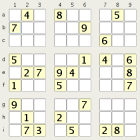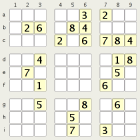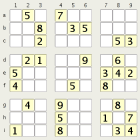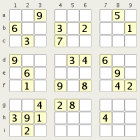Now that it's more and more difficult to find Sudoku grids that the CyberJerry Sudoku Analyzer (the 'Analyzer') can't analyze step by step, the great Sudoku Challenge is also becoming more difficult. To help out a bit, below are four Sudoku grids that the Analyzer can't analyze step by step. You just have to figure out how to solve one of these analytically (no guesswork) to qualify as a successful Sudoku Challenger. Click on any of the grids to bring it up in the Analyzer. Both it and you should be able to solve several cells. But at some point, the Analyzer gets stuck and can't give a hint. Can your brain keep analyzing beyond that point, and solve the puzzle? If so, click on the corresponding 'Answer Challenge' link and tell me how you did it. As before, I promise to publish your success.
With my brain, I know how to analyze and solve one of the grids below; am not telling which one.(Note 1) But programming the Analyzer to do it would be a bear, and am very unlikely to tackle that job in the near future. Even less likely for the other three, which my brain can't (yet) figure out. So you have lots of time to meet this challenge. Good luck!
Note 1 (17 July 2020): It was the third one that i could solve with my brain but thought too difficult to program the Analyzer to solve. Surprisingly, after correcting a minor bug, the Analyzer now solves it, in a way that my brain hadn't anticipated. Looks like my brainchild is smarter than my brain. So, anyway, the third one above is now a different Sudoku, one that, like the other three, neither my brain nor the Analyzer can analyze step-by-step.
| 0 comments | rev. Jul 17 2020 7:49pm |
When the Unique Rectangle technique is unavoidable
Fri June 19 2020 9:24pmSudoku
A recent round of minor enhancements and corrections has made the CyberJerry Sudoku Analyzer capable of analyzing increasingly tough Sudokus. Two results: the "New Puzzle" control now offers a "Genius" level, and the "Hint" feature may offer extremely complex hints, containing many interdependent sub-steps of a variety of advanced strategies. The added focus on complex Sudokus has had another unforeseen result: the possibility of encountering what I call the "Unavoidable Avoidable Rectangle". (Not being able to find any mention of the phenomenon in any other website, I claim the right to assign this name to it.) Let me explain:

One of the advanced strategies is called the "Unique Rectangle" technique. A few Sudoku experts call it "Avoidable Rectangle", since it is based upon the "deadly pattern" that cannot exist in a valid single-solution Sudoku.
Ironically, in some complex Sudokus, this technique may be unavoidable. That is, at a given point in a given Sudoku, there may exist several ways to proceed. If one way involves the Unique Rectangle strategy, and you don't notice it, or choose to follow a different way, you may solve a different cell, inadvertantly cause the deadly pattern to disappear, and, with it, the Unique Rectangle step. In some cases, this means that subsequent hints may be much more difficult than if the Unique Rectangle technique had been used. In some rare cases, the Sudoku may become impossible to solve analytically without backtracking to the missed Unique Rectangle hint step.
The Sudoku grid shown above illustrates this. Navigate to that Sudoku and click the "Hint" button. The Analyzer will offer you a hint consisting of 3 parts. The third part is a Unique Rectangle, case C, based upon avoiding the 'deadly pattern' in rectangle b2-b3-i2-i3. If you follow this hint, you will solve for cells h3 or i5, either one of which will make the rest of this Sudoku easy to solve.
But there is an alternative, at first sight easier. Instead of the Unique Rectangle, you could notice the Naked Pair in cells b2-b3 and use that to solve cell a2. Now you ask for another hint. This time there is only one hint available, a two-part hint involving a different Unique Rectangle (case A), at a1-a6-b1-b6, allowing you to solve cell a1. Next another hint with a case A at b2-b3-i2-i3, solving cells i2 or b3.
At this point, the original deadly pattern at b2-b3-i2-i3 has disappeared, and you will have to labor through some very complex steps to solve cells h3 or i5, which have turned out to be key cells in solving the whole Sudoku.
In this respect, your human brain may have a distinct advantage over the Sudoku Analyzer, which doesn't remember past hint steps. By design, every point in the Sudoku is treated as a fresh start, calling for its own set of hints. Nor does the Analyzer bother much with hint steps that have not been randomly selected, as mentioned above. I may try to make the Sudoku Analyzer smarter in this regard. But in the meantime, be careful about overlooking a Unique Rectangle hint. It may end up being unavoidable and essential to reaching a full solution.
| 0 comments | rev. Jun 25 2020 7:40pm |
This blog article serves as both another bug report and as a candidate for the Sudoku Challenge .
This time, the Sudoku Analyzer cannot solve the Sudoku step-by-step. It should be able to. This is a known bug, recently discovered by yours truly, and which yours truly is working on, and hope to have fixed soon.
In the meantime, if you think you can solve this Sudoku analytically (no guesswork), (read article)
| 1 comment | rev. Jun 5 2020 9:45pm |
. . .that through death he might destroy him that had the power of death, that is, the devil. And deliver them who through fear of death were all their lifetime subject to bondage. (Hebrews 2:14b,15)
A blessed Holy Week, and a Joyful Easter to all who read this.
Panic over COVID-19 is growing along curious lines. Those who are closing their shops and offices (and churches) and hiding in their houses or behind surgical masks are generally the rich, the educated, and the elite. At least where I live, most folks who have to work for a living are trying to go about their daily business as usual. Is there (read article)
This Sudoku puzzle has me scratching my head.
The Sudoku Analyzer solves it step by step, giving clues along the way. Which is to say, it is not one of those occasional Sudokus which can only be solved in trial-end-error guesswork manner. But at a couple points, the Sudoku Analyzer gives very complex hints where simple hints are possible. This is not according to design. Then, in at least one very complex hint, several secondary hint steps are omitted, without which the complex hint is incomplete.
What's especially baffling is that these (read article)
| 0 comments | rev. May 22 2020 7:59pm |
It's probably a guy thing, like watching the car's odometer roll over to 100,000 miles. But, when you think about it, observing birthseconds is really no different than celebrating birthdays. Specifically, the occurrence of one's billionth birthsecond is a rather singular milestone in one's life span. It is the only birthsecond magnitude one can observe with any real appreciation. The next lower magnitude, that of 100 million seconds, occurs when one is just a tad over 3 years old, too young to grasp what such a number entails. The next larger magnitude, 10 billion seconds, occurs at an interval of over 300 years; no chance to observe that event.
Just shy of 32 years of (read article)
| 1 comment | rev. May 6 2020 11:50am |
Here are a couple more examples of true and false opposition, in which a hyper or exaggerated version of something becomes its very opposite:
Distributism vs. Capitalism
In conformity with modern parlance, I'm using here the term 'capitalism' to refer to our current experience of large corporate capitalism, what some might call late-stage capitalism. This is but a perverse exaggeration of a small-scale and more reasonable capitalism, what is now called distributism.
Distributism has been championed by such diverse thinkers as G. K. Chesterton and Thomas Jefferson. As the name suggests, distributism puts economic and political (read article)






